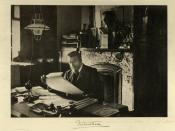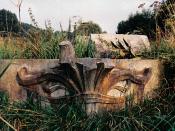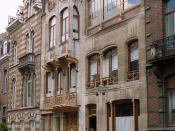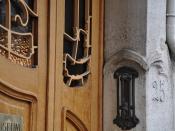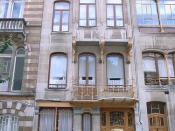One architect in particular has been credited with giving rise to the Art Nouveau movement: Victor Horta. Horta established a style that was unique to his architecture and design. It was through the use of iron, stone, wood, and glass that made his structure so complex and intriguing. Although the front and sides of his buildings were typically very ornate, the backs of the buildings were usually tremendously plain. Light played an important role in the way he designed his buildings. He incorporated glass windows and skylights into many of the rooms within his structures. His combination of mirrors and natural light gave the illusion of a continuous series of spaces. Horta maintained relationships and continuity between the interior and exterior of his structures through his use of materials. His expressive ironwork could be found on the façade of his buildings around the doors, windows, and balconies as well as on the interior on the handrails, furniture, windows, and doors.
His use of iron supported his style in many ways. It gave the space a rhythmic flow. The iron was manipulated into beautifully curved "whiplash lines." These lines created exquisite, organic forms, which flowed like wild vines; furthermore, it added a delicate femininity to the space. This was further accentuated by his flower like light fixtures.
Another common trait of Horta's designs focused on his elaborate staircases. He mastered the use of stone and iron. He paid close attention to even the minutest of details in creating these masterpieces. Using both his knowledge and excellent craftsmanship, Horta produced staircases that were exceptionally attractive. Murals were incorporated into many of Horta's staircases, which helped to emphasize the free-flowing, organic feel to the space.
